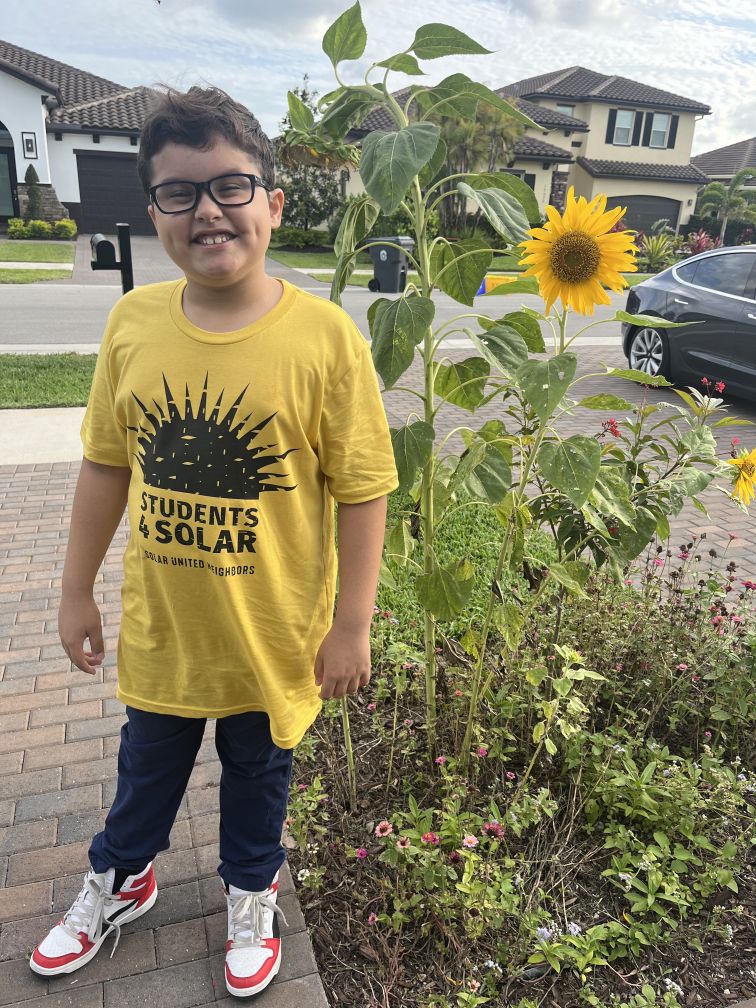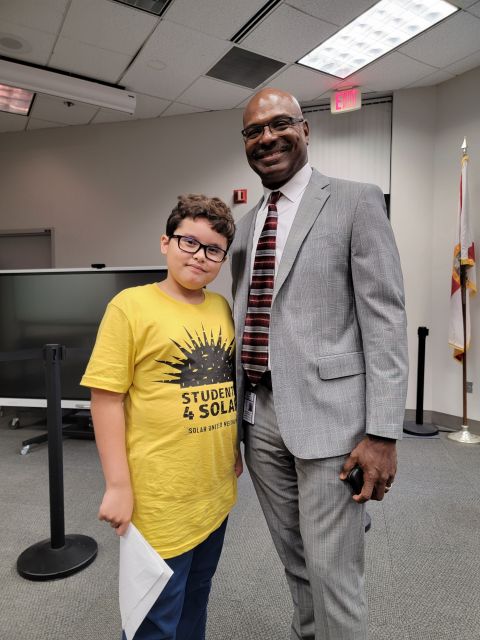By Ana Cristina Maldonado

“Hey, Mom! That school has solar panels on it!” My son, Nicolas Narvaez, who is in 4th grade at New Horizons Elementary School, pointed out the car window as we drove past Galaxy Elementary School in Boynton Beach.
We had put solar panels and an electric car charger on our house through Goldin Solar, a contractor, through a Solar United Neighbors Co-op, organized by the Palm Beach County League of Women Voters. But … solar on schools?! What an idea!
That was the beginning of Nico’s science fair project, calculating how much money his school would save if it switched to solar energy. The answer? A jaw dropping 5 million dollars in savings over 25 years from just one school. Multiplied by the number of schools in our District (236), that is $1.18 billion in savings over 25 years. That’s billion with a “B.” Imagine what educators could do with that money.
Energy is the second largest budget item for school districts after salaries. This year, our School District spent $40 million dollars. Here in the Sunshine State, most of our energy comes from natural gas (methane). Thanks to war and inflation, the cost of school electricity is already set to increase 67% over the next two years. (Florida Utilities Commission). This year’s $40 million dollars will be $66 million dollars in 2024-2025.
Solar schools can insulate the School District against these shocks… and even make us money. A school district in Arkansas installed 1,400 solar panels and turned a $250,000 deficit into a $1.8 million dollar surplus, resulting in a teacher pay raise of $2,000 to $3,000 per educator. https://energynews.us/2020/10/16/this-arkansas-school-turned-solar-savings-into-better-teacher-pay/
Yes, solar costs money up front. However, even if existing funds are accounted for, there are new opportunities and incentives that make solar more affordable than ever. The Inflation Reduction Act now allows schools to get a 30% to 50% direct cash payment for solar installation. This money is also available for churches and nonprofits – and this is new as of January 1, 2023.
A roof can last 25 years, but with incentives, rooftop solar can be paid off in under ten. New Horizons Elementary needs a new roof. Not adding rooftop solar is throwing money away.
Palm Beach County legislators Lori Berman and Joe Casello are sponsoring the “Emergency Shelters Preparedness Act” in Tallahassee. This bill needs our URGENT support. It will bring money for rooftop solar to schools that serve as hurricane shelters. Solar can guard against loss of power. https://capitalsoup.com/2023/01/19/senator-berman-and-representative-casello-reintroduce-emergency-shelters-preparedness-act-to-harden-shelters-against-extreme-weather-events-and-expand-solar-power/
Check out this link about how a solar community kept the lights on in Ft. Myers even after Category 5 Hurricane Ian. https://www.insider.com/babcock-ranch-florida-solar-power-town-survived-hurricane-ian-2023-2#:~:text=In%20September%2C%20Babcock%20Ranch%20survived,during%20the%20Category%204%20storm.

Palm Beach County School District believes in sustainability. We built the first LEED schools in Florida. My goal in speaking to the School District was to ask them to set an even more ambitious goal: Adopt a resolution like the one passed by Miami Dade Schools, committing to 100% Clean Energy by 2030. Check out Miami Dade County Public Schools’ Clean Energy Plan: https://api.dadeschools.net/WMSFiles/160/Clean%20Energy%20Report/Final%20clean%20energy%20report%20outline.docx%20-%20Google%20Docs.pdf
Why 2030? The United Nations Panel on Climate Change establishes that by 2030, we need to cut emissions by 45% to keep global warming to 1.5 degrees Centigrade… (that’s 2.7 Farenheit, for us Americans.)
I remember seeing the “hockey stick” climate emissions graph in eleventh grade. 2030 was an abstract concept to me then. This is not abstract to me now. My ten-year-old son is Class of 2031. https://en.wikipedia.org/wiki/Hockey_stick_graph_(global_temperature)
Seven years is not a lot of time. What if we miss that target? These are fears and fears bring paralysis. We have to overcome that. When you miss your exit on I-95, you refocus on your destination, check your map, and get off at the next exit.
If my 4th grader can do the math, so can everyone else.

Nico and I spoke to the School District in our presentation, but also, we were speaking to all of you: individuals, consumers, homeowners, the Village of Wellington, businesses, religious organizations, schools and municipalities in Palm Beach and across Florida.
Miami Dade County Public Schools has given us a great institutional model. If we set an ambitious goal, make a good plan to get there, staff it properly and act with urgency, we can do it.
This is the Sunshine State, and we are in it together.
My contact information:
Ana Cristina Maldonado
561-301-5174
Video of the School Board Meeting. Nico at 1h52min, I’m right afterwards.
https://www.palmbeachschools.org/Page/2090
Great link on electrification:
***
Nicolas (Nico) Narvaez is 10 years old. He is in 4th grade dual language Choice program at New Horizons. He loves math and the environment and video games.
Ana Cristina Maldonado is Nico’s proud mama. She is an attorney mediator with Upchurch Watson White and Max.

